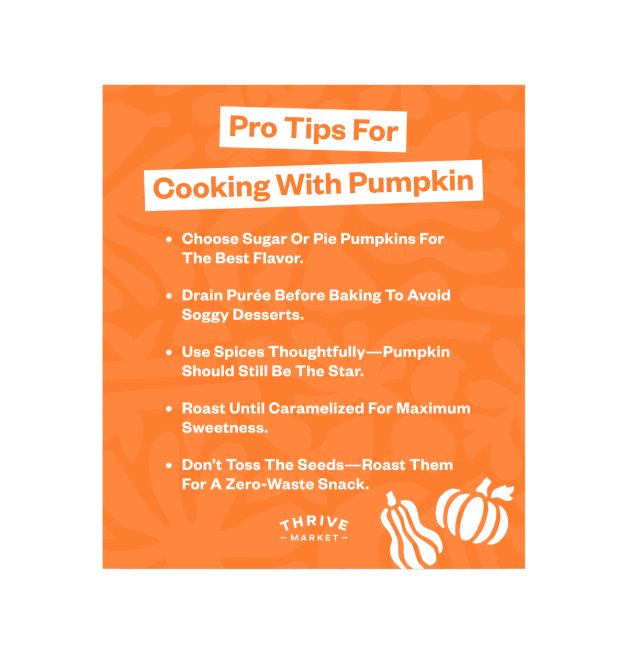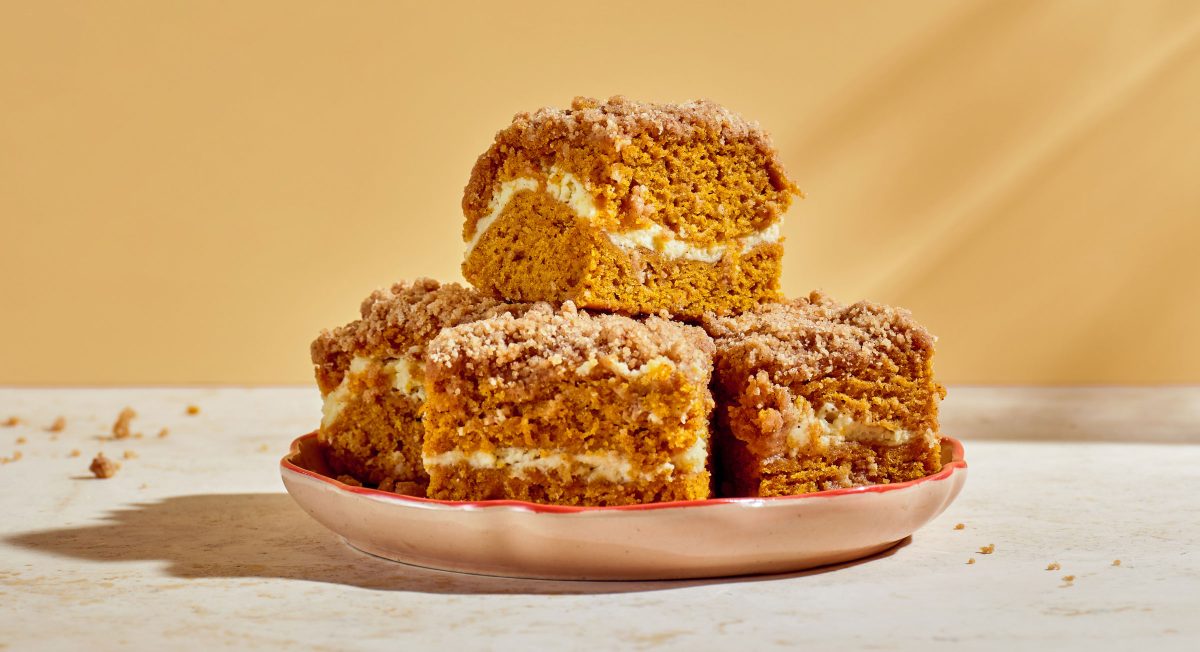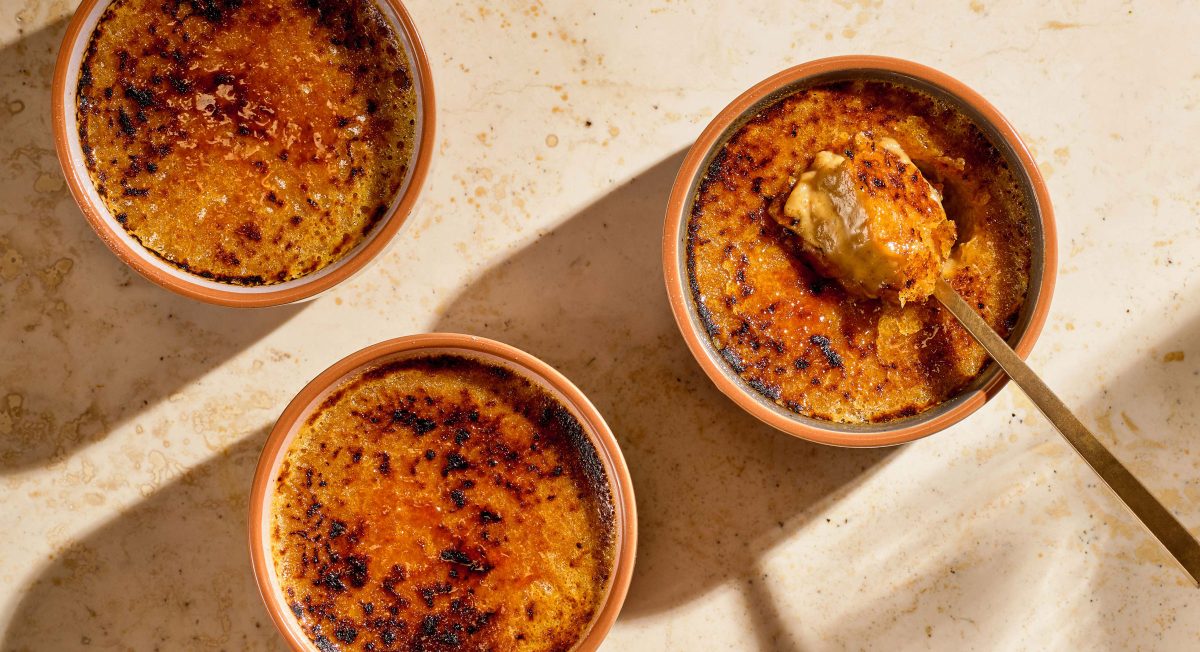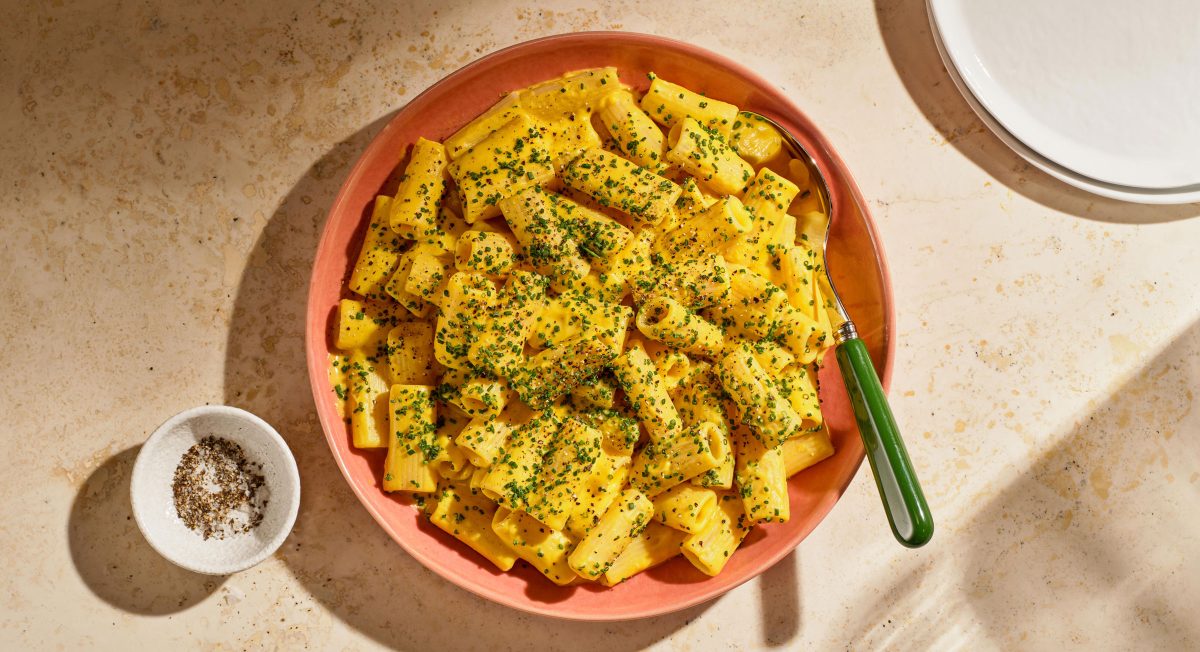The taste of pumpkin is almost synonymous with the fall season. Every year, it seems to come back around earlier and earlier (to the delight of many, no matter how many snarky remarks you may see on social media).
Pumpkin is a type of winter squash; an incredibly versatile one, at that. When served sweet, it adds richness to cookies, muffins, and most famously, pumpkin pie. When served savory, it adds a creamy, earthy flavor to pastas, soups, and even warm salads and grain bowls.
Whether you stock up on canned pumpkin at the first chill of autumn or you plan to process and prepare a whole pumpkin for your fall cooking and baking plans, we’ve gathered a list of the best pumpkin recipes and cooking tips to get you started.
How to Roast Pumpkin
Roasting pumpkin at home is a simple way to unlock its natural sweetness and create a versatile base for soups, baked goods, or seasonal sides.
- Start by choosing a small sugar pumpkin, which is ideal for cooking.
- Give it a quick rinse, then slice it in half and scoop out the seeds (set them aside—you can roast those later for a crunchy snack).
- Lightly brush the cut sides with olive oil and place the halves cut-side down on a parchment-lined baking sheet.
- Bake at 375°F until the flesh is fork-tender, usually about 35 to 45 minutes depending on size.
- Once cooled, the skin will peel away easily, leaving smooth, golden flesh that can be enjoyed as is or blended into purée. For extra flavor, you can sprinkle the pumpkin with warming spices like cinnamon or savory options such as smoked paprika before roasting.
Spices to Pair With Pumpkin
Pumpkin pairs beautifully with warming spices. Here are some suggestions for sweet and savory dishes.
In sweet dishes:
For savory recipes:
- Cumin
- Coriander
- Smoked paprika
- Chili powder (for a bit of heat)
Pumpkin FAQ: Cooking Tips, Storage, and More
How do I choose the best pumpkin for cooking (or baking)?
Look for smaller pumpkins labeled “sugar” or “pie” pumpkins — they’re usually around 2 to 4 pounds and have dense, sweet flesh that works well in recipes. Large carving pumpkins are best left for jack-o’-lanterns, since their flesh tends to be stringy and bland.
What’s the difference between pumpkin purée and pumpkin pie filling?
Pumpkin purée is just cooked pumpkin with no added ingredients. Pumpkin pie filling, on the other hand, is typically pre-sweetened and spiced with ingredients like cinnamon, nutmeg, and sugar. For most recipes, stick with pure pumpkin purée so you can season and sweeten to your own taste.
How long does canned pumpkin last once opened?
Once opened, canned pumpkin should be transferred to an airtight container and stored in the refrigerator. It typically keeps for up to a week. If you don’t think you’ll use it all within that time, freezing is a smart option.
How do I make pumpkin purée from fresh pumpkin?
Start with a sugar pumpkin (sometimes called pie pumpkin), as these are naturally sweeter and less watery than carving pumpkins. Simply cut the pumpkin in half, scoop out the seeds, and roast until tender. Once cooled, scoop out the flesh and blend until smooth. Homemade purée may add a slightly deeper flavor and texture to baked goods, soups, and sauces.
How do I use pumpkin seeds?
Pumpkin seeds, also called pepitas, can be roasted with olive oil and spices for a crunchy snack, sprinkled over salads, or blended into sauces and dips. They’re also a versatile pantry ingredient that can add texture and flavor to baked goods or grain bowls.
Can I freeze pumpkin purée, and how long will it last?
Yes, pumpkin purée freezes well. Store it in freezer-safe bags or containers, ideally in recipe-friendly portions (like 1-cup amounts). Frozen pumpkin purée can last up to 3 months, and thawed purée is best used in baked goods, soups, and sauces.
Pumpkin Cooking Tips for Success
Pumpkin can shine in both sweet and savory dishes when prepared with a few simple techniques. Keep these tips in mind to make the most of this seasonal favorite:
1. Pick the perfect pumpkin
Choose smaller sugar or pie pumpkins, which have smooth, dense flesh and a naturally sweet flavor. They’re ideal for roasting, baking, and puréeing.
2. Roast for depth of flavor
Roasting caramelizes pumpkin’s natural sugars, creating a richer taste and creamier texture. A drizzle of olive oil and a sprinkle of salt is all it needs before going into the oven.
3. Enhance with complementary flavors
Pumpkin pairs well with warming spices like cinnamon and ginger in sweet dishes, and savory flavors like garlic, sage, or cumin in mains and sides. Balancing sweet and savory notes helps elevate recipes.
4. Use pumpkin across your menu
Think beyond pie — pumpkin can be blended into soups, stirred into pasta sauces, baked into muffins, or even used in smoothies. Its mild flavor makes it a versatile base ingredient.
5. Store smartly
Fresh pumpkin should be refrigerated once cut and used within a few days. Purée can be frozen in portioned amounts so it’s ready for future meals.
Mistakes to Avoid When Cooking with Pumpkin
Pumpkin is a versatile ingredient, but a few common missteps can make recipes less than satisfying. Here are some pitfalls to watch for, plus easy ways to avoid them:
1. Using the wrong type of pumpkin
Large carving pumpkins are bred for appearance, not flavor. Their flesh is often watery and stringy. For cooking or baking, stick with sugar or pie pumpkins, which are smaller, denser, and naturally sweeter.
2. Skipping the drain step with purée
Whether homemade or canned, pumpkin purée can hold extra liquid. If you’re baking, this excess moisture may make recipes heavy or soggy. To fix this, simply place the purée in a fine-mesh strainer or cheesecloth and let it drain before using.
3. Overpowering the flavor with spices
Pumpkin has a delicate, earthy sweetness. While spices like cinnamon, nutmeg, or cumin complement it beautifully, too much can overwhelm the natural flavor. Try balancing warming spices with a little salt or savory herbs to let the pumpkin shine.
4. Not roasting long enough
Undercooked pumpkin can taste bland and have a firm, chalky texture. Roast until the flesh is fork-tender and lightly caramelized, which brings out a deeper sweetness and a creamier consistency.
5. Forgetting the seeds
Many people discard pumpkin seeds, but they’re a valuable part of the fruit. Roasted with olive oil and a pinch of seasoning, they make a crunchy snack or salad topping — plus, it’s a sustainable way to use the whole pumpkin.

3 Pumpkin Recipes to Try This Fall
A savory, cheesy pasta, a morning-ready coffee cake, and a perfectly Parisian crème brûlée — just three of the most delicious ways we plan to cook with pumpkin this fall.
Pumpkin Streusel Coffee Cake

Yield: 12 servings
Active Time: 20 minutes
Total Time: 1 hour 30 minutes
Ingredients:
For the cake:
2 tbsp grapeseed oil
1 egg
½ cup granulated sugar
¼ cup brown sugar
¾ cup pumpkin puree
2 ¼ tsp pumpkin pie spice
1 tsp vanilla
1 ¾ cups flour
1 ½ tsp baking powder
½ tsp sea salt
½ cup milk (or your favorite plant-based milk)
For the streusel topping:
4 tbsp butter, melted
¾ cup flour
½ cup brown sugar
1 tsp cinnamon
For the cream cheese filling:
8 oz cream cheese, softened
1 egg yolk
1 tbsp flour
¼ cup granulated sugar
1 tsp vanilla
Instructions:
Preheat the oven to 350ºF. Line a 9×9-inch baking pan with parchment paper and grease lightly.
To make the cake, mix the grapeseed oil, egg, granulated sugar, and brown sugar in a stand mixer (or with an electric hand mixer) until pale and light. Add the pumpkin puree and vanilla extract and mix until combined. Add the flour, baking powder, and sea salt and mix on low speed while pouring in the milk, just until combined.
To make the streusel topping, combine all ingredients in a small bowl and pinch together until crumbly.
To make the cream cheese filling, combine all ingredients in a medium bowl until smooth.
Assemble the coffee cake by adding half of the cake batter to the bottom of the pan and spread evenly. Spread the cream cheese layer on top, then add the remaining cake batter and spread to the edges. Sprinkle the streusel topping over the top in an even layer.
Bake the cake for 45 to 50 minutes, until the streusel is lightly browned. Let cool completely before slicing into squares. Enjoy!
Pumpkin Crème Brûlée

Yield: 5 individual servings
Active Time: 10 minutes
Total Time: 15 minutes, plus 4 hours chill time
Ingredients:
8 egg yolks
¾ cup granulated sugar
2 cups heavy cream
½ cup pumpkin puree
1 ½ tsp pumpkin pie spice
¼ cup extra granulated sugar, for topping
Instructions:
Preheat the oven to 325ºF.
Combine yolks, sugar, pumpkin puree, and pumpkin spice in a mixing bowl.
Gently heat the cream until just simmering. Pour into the yolk mixture and whisk until combined.
Place 5 ramekins inside a rectangular baking dish. Divide the batter evenly between the ramekins, then fill the baking dish with enough hot water to submerge the ramekins half way.
Cover the baking dish with foil and bake for 45 minutes. Remove the foil and bake 5-10 minutes further, until the centers of the custard are slightly jiggling and edges are set.
Let cool completely. Cover and refrigerate for at least 4 hours or overnight. (Note: if you use shallower ramekins, they will bake faster).
Remove the custards from the fridge and sprinkle a layer of sugar on top of each. Use a culinary torch to melt the sugar. Serve immediately. (Note: If you don’t have a culinary torch, you can also broil them on the top rack of the oven for 3-5 minutes, checking often to make sure they don’t burn.)
Pumpkin & Feta Pasta

Ingredients:
1 block feta
1 shallot, quartered
1 ½ lbs pumpkin or butternut squash, cubed (4 cups chopped)
½ tsp red pepper flakes (optional)
1 tsp sea salt
2 tbsp olive oil
1 lb pasta of choice
Chives, sliced
Grated Parmesan
Instructions:
Preheat the oven to 400º F. Add the feta, shallot, squash, red pepper flakes, sea salt, and olive oil to a baking dish. Bake for 35-40 minutes, until the squash is tender. Let cool for 5-10 minutes.
Meanwhile, bring a large pot of salted water to a boil. Cook the pasta according to package directions. Reserve 2 cups of pasta water, then drain.
Add the squash and feta mixture to a blender or food processor. Blend until creamy and smooth, adding 1 ½ cups pasta water to thin it out.
Add the pasta back to the pot with the pureed sauce. Heat on low and stir until combined. Stir in the remaining pasta water if needed. Serve hot, topped with chives and grated Parmesan cheese.